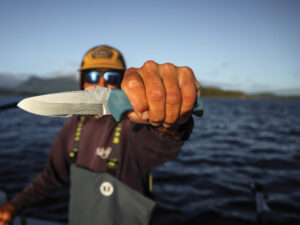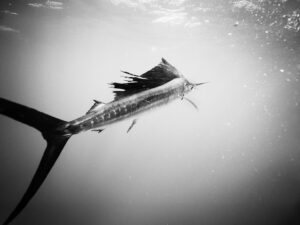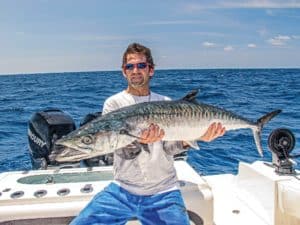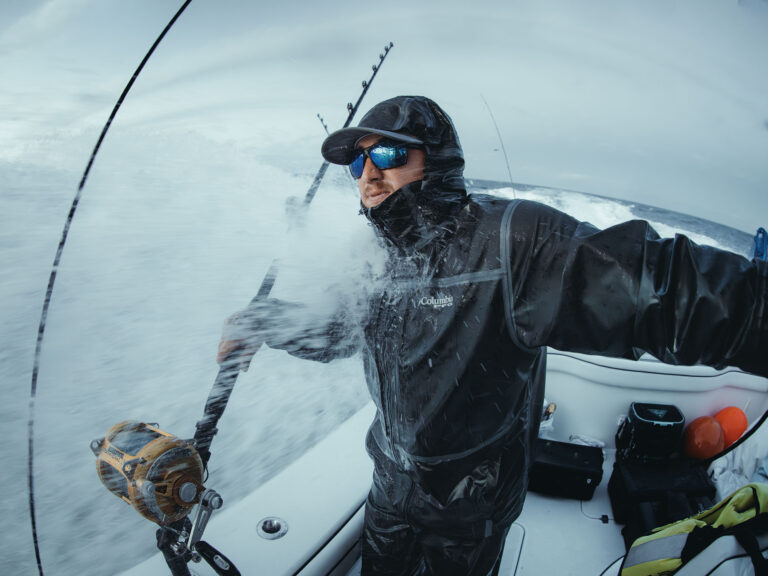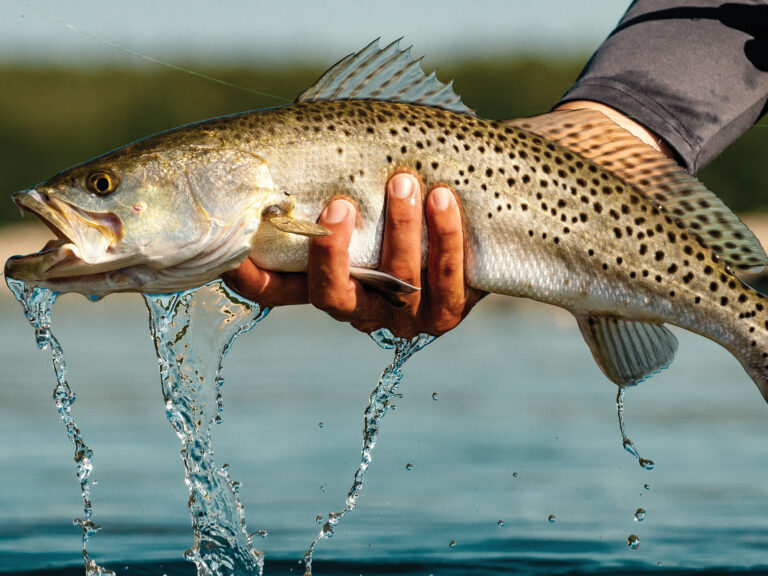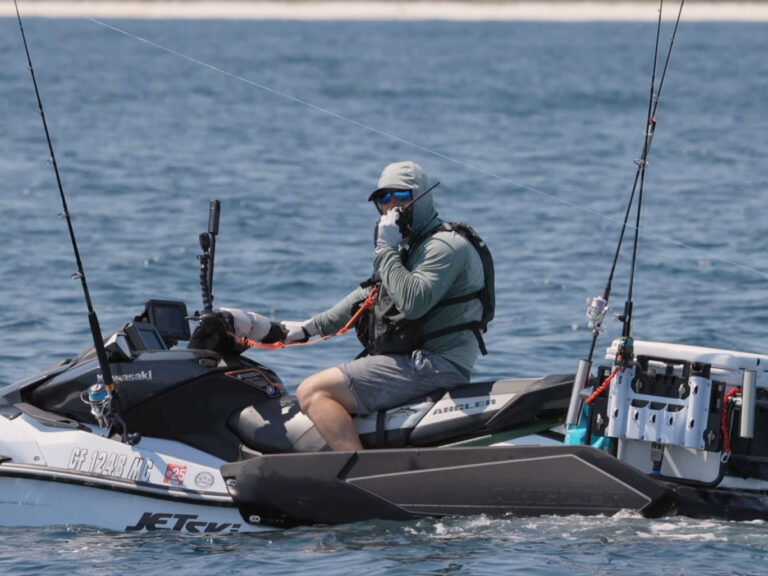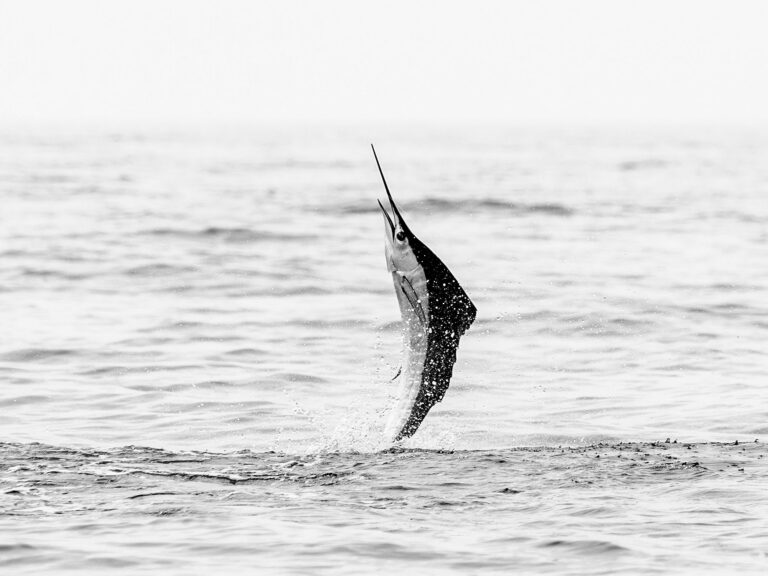
For as long as anyone can remember, there’s been a solid seasonal yellowfin troll bite in the mid-Atlantic canyons, and certainly a few were caught when anglers stopped and threw plugs at busting fish. But a directed surface-plug fishery for yellowfins is fairly new. A handful of hardcore “jig-and-pop” anglers, spawned from the recent topwater bluefin craze, have developed the knowledge and techniques to have successful trips fishing solely with topwater plugs.
When you troll, a knockdown can be exciting, but feeling the strike and that initial blistering run is one of the defining factors of a tuna encounter. And I don’t think anyone would disagree that the fight is a lot more fun on spinning tackle than on a 30-wide trolling setup.

30 Fathoms
Since 2009, a notable aggregation of yellowfins has occurred in under 200 feet of water. “With a few exceptions, they show up in what are generally the same areas as the bluefin we are catching earlier in the season,” notes New Jersey Capt. Gene Quigley.
In late July, you may catch one or two bluefins in the morning. Then you catch a yellowfin, and in the space of a couple of hours, you won’t encounter any more bluefins, it’ll be all yellowfins. And this pattern lasts through August and September. You generally don’t see bluefins again until much later, usually December.
Why are they here? Because of the bait! It is almost a certainty that these yellowfins come in here to feed on the sand eels that aggregate in the 150- to 180-foot depths.
It also seems clear that this shallow depth (for yellowfins, anyway) isn’t terribly conducive to trolling. Certainly, trolling through whatever life you might have out there (whales, dolphin, skipjack or albie schools) is likely to put it down or break it up, and then the yellowfins are gone too.
Unlike bluefins, which tend to show up in schools of similar-size fish, once you get on yellows, their size varies quite a bit. “When we get on ’em, we catch a lot of small fish,” says Crochetiere, “and the 80-pounders are just randomly mixed in.”

Find ‘Em
“You’ll want to look for at least 74-degree water in that depth range,” Crochetiere says. “You want clear blue water too,” Quigley notes. “Clean and green doesn’t cut it most of the time.” Yes, we’ve caught them in green water before, but it’s really only after it was blue a day or two before and the fish have stuck around for a few days. Subscribing to a satellite-shot website like Terrafin or RipCharts will help you get an idea of where the warm blue water is before you head out.
Once you have a line on such water, look for life: whales, dolphin, rays, storm petrels (aka tuna chicks), and turtles. Stuff that indicates there’s bait around. Certainly, it’s good to find baitballs on your sounder, but it is not a necessity. “In recent years, most of, if not all, the bait appears to be on the surface to about 30 feet down,” Quigley says.
Once you find such life, start casting. Blind-casting might seem silly if you’ve never done it offshore. But it really does work. And I argue it catches just as many, if not more, fish than if you were trolling. There is nothing more awesome than getting caught off guard when a yellowfin crashes your plug without warning.

Gear Up
“Covering as much ground as you can on a cast is important,” says Saltywater Tackle owner Sami Ghandour. “Anglers need a longer rod with a relatively soft tip but plenty of backbone.” Rods up to 8 feet are pretty standard for the offshore popping game. But I’ve found popping rods from 7 to 8 feet are just about perfect. They allow you to get a popper or a stickbait out there but also give you plenty of lifting power when that fish runs deep.
As far as reels go, you’ll want something that can apply at least 30 pounds of drag. Some anglers spool up with 100-plus-pound braid, but I use 60-pound PowerPro Hollow-Core Ace. Keep in mind that we’re talking about 50- to 80-pound fish. Sure, they get larger than that, but it’s rare to find a fish in these parts that exceeds 100 pounds.
Slow and Loud
While bluefins seem to prefer stickbaits, with the yellowfins it’s all about the popper. The more water a plug pushes, the better.
Madd Mantis makes what I consider to be the best all-around popper for yellowfins. At 6.5inches, the Atasi Popper weighs just about 3 ounces, so you can really wing, and the reflective-tape colors elicit savage strikes. When worked correctly, you will get a deep pop that throws a ton of water.
“We work them slow and deliberate,” Crochetiere says. “It’s almost counterintuitive how slow you need to work them with yellowfin.”
We throw them out, do a long, sweeping pop, let them sit for two or three seconds, and repeat. About 90 percent of the strikes come on that pause.
Stickbaits work too, particularly on flat-calm days. We catch a lot of fish on the 7.5-inch, 3-ounce floating Shimano Orca with the same retrieve: sweep and pause. Most of the strikes come on the pause. During the sweep, the plug should dive underwater and then pop back up.
In the end, committing to a day of plugging for yellowfins takes resilience and determination. But the rewards are great. And while it takes experience to get it right, we catch just as many fish as the trollers. And we have way more fun!

SWS Planner
What: Yellowfin tuna
Where: 30 fathoms, from New York to Delaware
When: August and September
Who: The following captains excel at the topwater tuna game:
New York
Capt. John McMurray and Capt. Cory Crochetiere
New Jersey
Capt. Gene Quigley and Capt. Jim Freda

SWS Tackle Box for Yellowfin Tuna
Rods: 71⁄2- to 8-foot heavy tuna popping rods (Saltywater Tackle El Maestro 710 or Race Point 150)
Reels: Shimano Stella 18000, Van Staal VSB250 or equivalent
Line: 60-pound hollow-core braid with 6 feet of 80-pound fluoro leader
Lures: Big poppers such as the Madd Mantis Atasi Popper; tuna-ready stickbaits such as Shimano’s 71⁄2-inch floating Shimano Orca
Learn the Tells
“The storm petrels are the big indicator,” Crochetiere says. “When you find them, start throwing plugs because there’s a good chance there are yellowfin tuna around.”
Schools of skipjack or false albacore that most captains pass by deserve attention. These schools feed on sand eels on the surface, the same forage yellowfins seek.
“When you throw big poppers or big stickbaits into them, the yellowfin come up and explode on them,” Phelan says.
In recent years, we’ve had large aggregations of cownose rays in that 30-fathom area. It is always a good idea to throw plugs around such schools, as tuna cruise just underneath and on the outskirts.

Flipper Knows
The dolphin thing may be the most exciting. You have to get in front of a school of dolphin and throw a plug at the head of the school. We catch a lot of fish with this technique. And it’s super-high-adrenalin fun.
Don’t Forget the Peanuts
Having live bait helps. During the last couple of years we’ve had an abundance of juvenile menhaden (aka peanuts) in our bays. Leaving the dock with a few hundred ups the odds significantly.
“When we set up, I’ll start taking handfuls of peanuts, squeezing them a bit so they are stunned, and toss them in while my anglers are throwing plugs,” Quigley says. “This tends to bring the fish to us rather quickly.”


